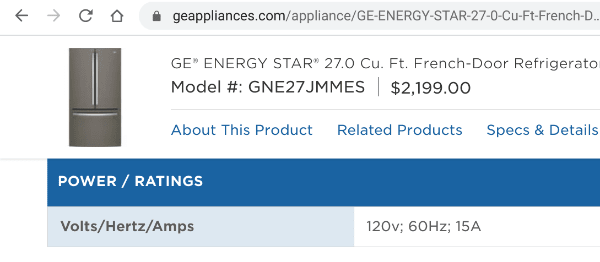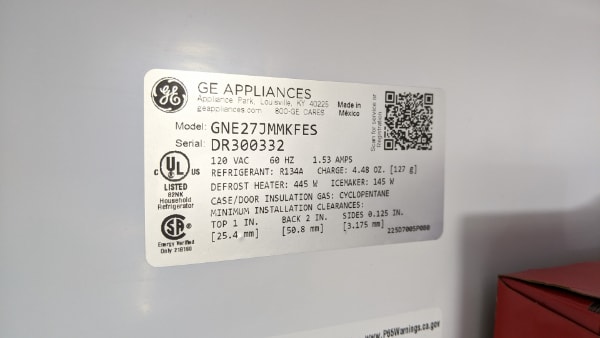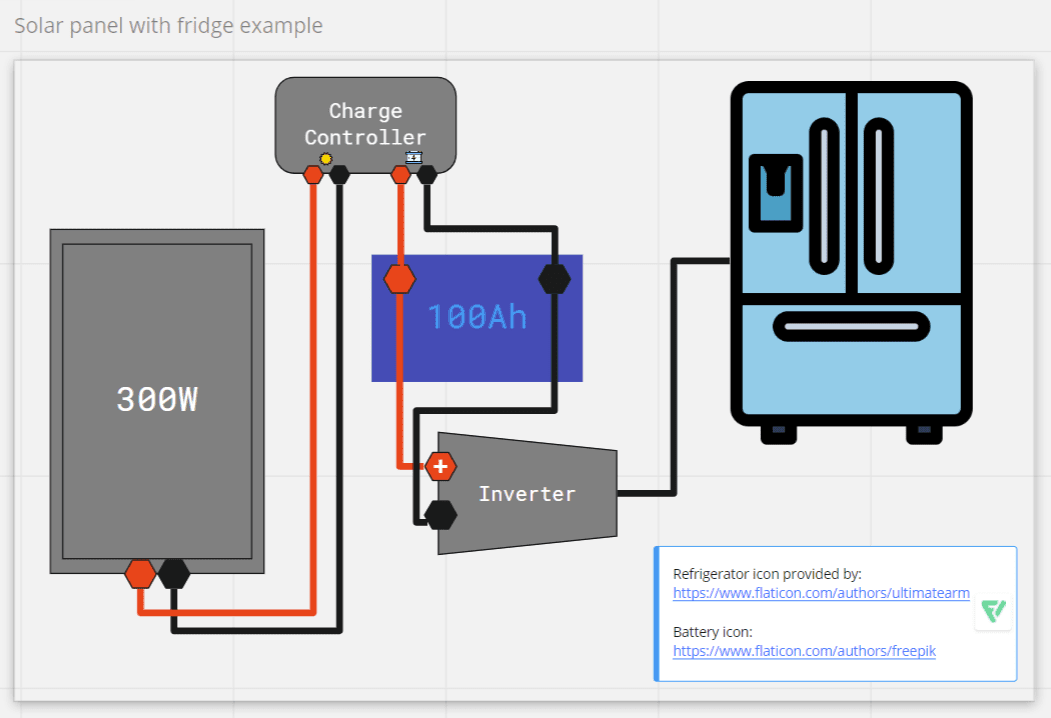A fridge uses a lot of energy, but not too much to run on solar. Running a refrigerator on solar panels may seem like a difficult and impossible task, but it’s a common misconception that is going to be addressed in this post.
With an average ENERGY STAR rated (~19 cubic feet) refrigerator, it will take 2-3 solar panels to power. This is taking into account a 300W rated panel and an average 15-amp, 120V refrigerator.
For this post, it’s focused on a refrigerator that is average in a home. It isn’t a small portable fridge, but not a massive 27 cu. ft. commercial refrigerator either.
First step: finding the correct information to answer the question of how many solar panels you need is crucial to ensuring power needs are met.
Here are three ways to find out the power rating for the fridge you want to power with solar panels.
- Go to the manufacturer’s website. Even if it isn’t the manufacturer’s website, you can usually still find this information on store websites like Best Buy. Look for technical specifications.
- Look inside the door of the refrigerator – an image of mine is below. This will show information like how many volts, amps, and even the wattage of the defrost heater or ice maker.
- Find the EnergyGuide label to understand usage for your refrigerator appliance. This has an estimated annual electricity use and cost.


How Long Will a Refrigerator Run on Solar Panels?
Depending on the number of solar panels you use to hook up to the fridge, your runtime is going to be affected by how much energy the refrigerator requires to stay cool.
Think about the needs for a refrigerator to stay cool on a hot day versus a cool day. In hot weather, it requires more energy since it’s being depleted from the heat.
Three factors that matter for refrigerator runtime
- Amount of solar power produced
- Battery storage (used when no sun is present)
- Power needs from the fridge
Let’s use the refrigerator in my kitchen as an example. First, the specs:
- 27 cubic feet 😮
- 120V
- 1.53 amps
- 445W Defrost Heater, 145W Icemaker (we’ll talk about these further down)
Figure out the refrigerator’s running wattage
To figure out the total [running] wattage needed, calculate 1.53 * 120 = 183.6 watts.
Find out highest need for peak wattage
Remember the defrost heater and icemaker? For my fridge, we need to calculate the highest amount of energy needed in total, in order to size the solar panels correctly.
Just to be safe, I’ll add the running watts + defrost heater + icemaker. The numbers are: 183.6 + 445 + 145 = 773.6 watts.
Here’s a quick calculator to help estimate how many solar panels are needed based on your kilowatt-hours per month.
Average Refrigerator Energy Consumption Per Year, Month, and Day
It always helps me to understand the amount of power (kWh) needed for each day. Sometimes it can help taking it to how much power is needed per hour.
After starting to compare different refrigerators and their consumption, I decided to stick with Samsung and use different sizes of cubic feet to show a comparison chart.
Kilowatt hours (kWh) required for three different Samsung refrigerators
| Fridge Size | Day | Month | Year | No. of panels |
| Power in kWh | ||||
|---|---|---|---|---|
| 22.6 cu. ft. | 1.9 | 57.5 | 690 | 4-6 |
| 27.8 cu. ft. | 2.09 | 62.9 | 755 | 4-6 |
| 17.6 cu. ft. | 1.23 | 37.1 | 446 | 3-4 |
Sometimes breaking down the numbers to the hour is really helpful. If you need to find out how to really compare an hour-by-hour energy consumption vs. production, kWh comes in handy. This can be used by the amount of sunlight the solar panels will get in a typical day.
Let’s take a look at one of the Samsung refrigerator’s numbers. Looking at the 22.6 cu. ft. option using 1.9 kWh daily, turned into watts first for simplicity.
1.9 * 1000 = 1900 watts
Now it’s easier to take 1900 / 3 (hours) to see that we need to produce 633 watts/hour to keep up with the fridge’s [all-day] demands. Since we’re trying to run it for 24 hours, we need to produce a really good amount while we have sun.
What Else is Needed to Use a Fridge on Solar Panels?
Going back to our three factors that matter for refrigerator runtime, you will also need other items – a battery that matches the voltage of the solar panel (i.e. a 12V solar panel needs a 12V battery) and some way to connect the battery to the panels – known as a charge controller.
In addition to both a charge controller and a battery, an inverter is needed to convert the DC to AC so that the refrigerator can be plugged into the power source.

An exception to the inverter is if you are using a 12-volt refrigerator. Sometimes these can be found where RV accessories and equipment are sold or 12V refrigerators on Amazon.
You might consider using a DC fridge compared to AC if you’re trying to minimize energy loss and be more efficient.
Newer technology like the ACOPOWER LiONCooler Rechargeable Solar Fridge Freezer come with a battery included! So the only thing you’ll need to hook-up to it is a solar panel. They do also have a model that has a battery AND a solar panel.
Factors to Consider When Sizing a Solar Set-up for a Refrigerator
There are other things to keep in mind when it comes to sizing how many solar panels you will need. Since people have different habits, these habits will affect the longevity of the fridge.
Let’s review a few items that affect the power need:
- Opening and closing a fridge door constantly will affect the demands for power.
- The amount of food inside will actually help stay cooler longer given that the door remains closed and heat doesn’t come in.
- Whether the refrigerator has a freezer or not
Does a Refrigerator Maintain Consistent Power on Solar Panels?
A refrigerator changes based on the conditions around it and may not need to turn on or off as often. An air compressor and ambient room temperature will affect the length of time for internal cooling.
Related and FAQ
How Much Energy Does an Average Refrigerator Use?
19-21 cubic feet is the measurement for your typical fridge. Most families fall into the 21+ range to accommodate enough food for everyone. Here’s an entire article amount determining the amps for a fridge.
How Does a Refrigerator Run on Solar Panels?
Solar panels take the energy from the sun in the form of DC (direct current) and use it to run power to a refrigerator.

